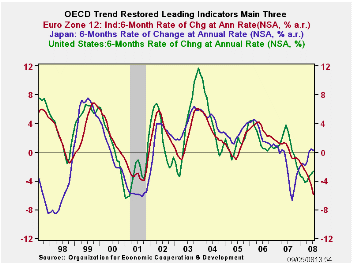 Global| Sep 05 2008
Global| Sep 05 2008OECD LEIs Continue to Sag as Japan Bucks Trend
Summary
OECD Trends. The OECD trend-adjusted LEIs show clear ongoing declines. The OECD declines are getting progressively weaker for the entire area as well as for the OECD seven and for the OECD four. In the US, however, the OECD LEI is [...]

OECD Trends. The OECD trend-adjusted LEIs show clear ongoing declines. The OECD declines are getting progressively weaker for the entire area as well as for the OECD seven and for the OECD four. In the US, however, the OECD LEI is still declining but is dropping at a decelerating pace. The US LEI grew at the strongest pace one year ago and now its Yr/Yr pace is only in line with other OECD measures while its 3-month and 6-month pace is stronger than the other comparable OECD measures.
The OECD says. The OECD characterizes the G7 reading as consistent with a still-weakening climate. The OECD reports that the growth cycle outlook is for a slowdown in the OECD area, G7 area and Japan, while for the Euro area a strong slowdown is anticipated. "OECD composite leading indicators for July 2008 indicate a continued weakening outlook for all the major seven economies," the OECD said in its monthly release. "The latest data for major non-OECD member economies tentatively point to expansion in China, Brazil and Russia and a downturn in India," it said.
Selected Countries. Italy's composite indicator fell the sharpest of all the G7 countries, off 1.9 points on the month. The German and Canadian indicators dropped 1.5 points. Japan's indicator fell 0.5 point and the United States saw a 0.2 point fall.
Comparison with past US turning point. The US indicator is weak but did not get as weak as it did in or before the last economic downturn. It is now rising from its current cycle low. In Japan the index reach a spike low as weak as it was in the last recession but it did not stay impacted for as long as it did last time. The Japanese index is now rising. The index for the Euro-Zone economies is much weaker than it was at the time of the last US recession and it is still dropping at an increasing speed.
| OECD Trend-Restored Leading Indicators | ||||
|---|---|---|---|---|
| Growth progression-SAAR | ||||
| 3Mos | 6Mos | 12mos | Yr-Ago | |
| OECD | -4.6% | -3.6% | -3.3% | 1.9% |
| OECD 7 | -3.8% | -3.4% | -3.9% | 1.3% |
| OECD Europe | -9.0% | -6.8% | -4.5% | 1.1% |
| OECD Japan | 0.9% | -0.4% | -0.9% | -1.2% |
| OECD US | -0.5% | -1.8% | -3.8% | 2.5% |
| Six month readings at 6-month intervals: | ||||
| Recent six | 6Mo Ago | 12Mo Ago | 18MO Ago | |
| OECD | -3.6% | -2.9% | 1.7% | 2.2% |
| OECD 7 | -3.4% | -4.3% | 1.4% | 1.2% |
| OECD Europe | -6.8% | -2.2% | 0.6% | 1.5% |
| OECD Japan | -0.4% | -1.5% | -3.7% | 1.4% |
| OECD US | -1.8% | -5.7% | 3.5% | 1.5% |
| Slowdowns indicated by BOLD RED. | ||||
Robert Brusca
AuthorMore in Author Profile »Robert A. Brusca is Chief Economist of Fact and Opinion Economics, a consulting firm he founded in Manhattan. He has been an economist on Wall Street for over 25 years. He has visited central banking and large institutional clients in over 30 countries in his career as an economist. Mr. Brusca was a Divisional Research Chief at the Federal Reserve Bank of NY (Chief of the International Financial markets Division), a Fed Watcher at Irving Trust and Chief Economist at Nikko Securities International. He is widely quoted and appears in various media. Mr. Brusca holds an MA and Ph.D. in economics from Michigan State University and a BA in Economics from the University of Michigan. His research pursues his strong interests in non aligned policy economics as well as international economics. FAO Economics’ research targets investors to assist them in making better investment decisions in stocks, bonds and in a variety of international assets. The company does not manage money and has no conflicts in giving economic advice.






